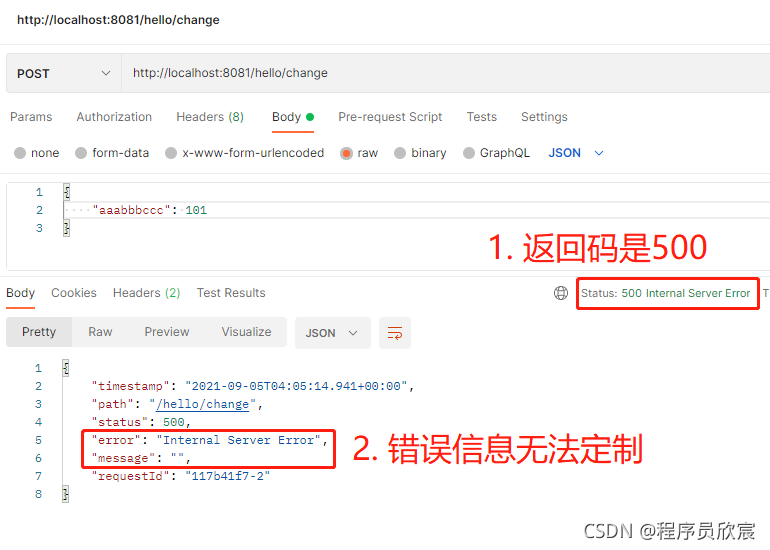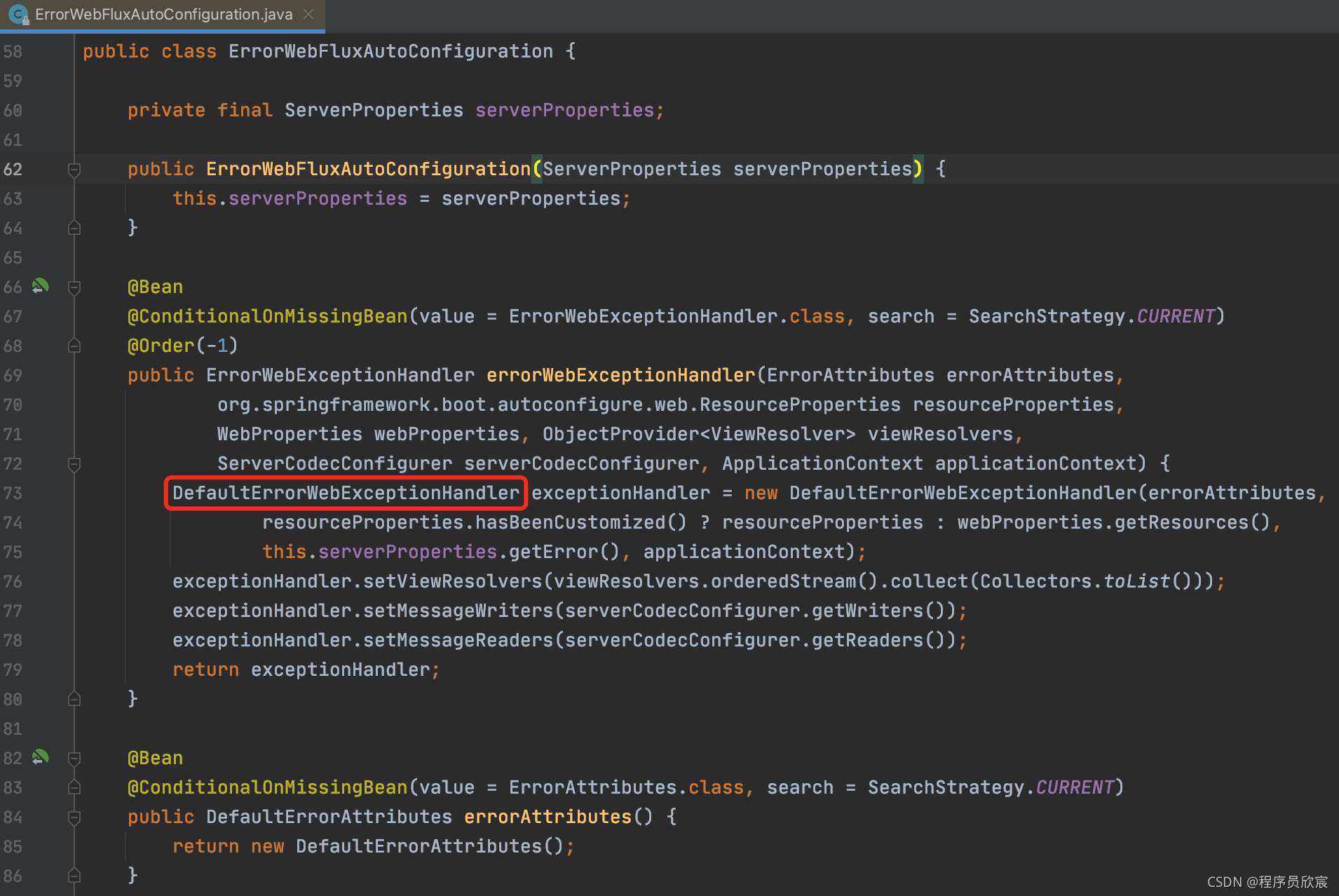Spring Cloud Gateway过滤器精确控制异常返回(分析篇)
欢迎访问我的GitHub
这里分类和汇总了欣宸的全部原创(含配套源码):https://github.com/zq2599/blog_demos
本篇概览
- 在《Spring Cloud Gateway修改请求和响应body的内容》一文中,咱们通过filter成功修改请求body的内容,当时留下个问题:在filter中如果发生异常(例如请求参数不合法),抛出异常信息的时候,调用方收到的返回码和body都是Spring Cloud Gateway框架处理后的,调用方无法根据这些内容知道真正的错误原因,如下图:

- 本篇任务就是分析上述现象的原因,通过阅读源码搞清楚返回码和响应body生成的具体逻辑
提前小结
- 这里将分析结果提前小结出来,如果您很忙碌没太多时间却又想知道最终原因,直接关注以下小结即可:
- Spring Cloud Gateway应用中,有个ErrorAttributes类型的bean,它的getErrorAttributes方法返回了一个map
- 应用抛出异常时,返回码来自上述map的status的值,返回body是整个map序列化的结果
- 默认情况下ErrorAttributes的实现类是DefaultErrorAttributes
- 再看上述map的status值(也就是response的返回码),在DefaultErrorAttributes是如何生成的:
- 先看异常对象是不是ResponseStatusException类型
- 如果是ResponseStatusException类型,就调用异常对象的getStatus方法作为返回值
- 如果不是ResponseStatusException类型,再看异常类有没有ResponseStatus注解,
- 如果有,就取注解的code属性作为返回值
- 如果异常对象既不是ResponseStatusException类型,也没有ResponseStatus注解,就返回500
- 最后看map的message字段(也就是response body的message字段),在DefaultErrorAttributes是如何生成的:
- 异常对象是不是BindingResult类型
- 如果不是BindingResult类型,就看是不是ResponseStatusException类型
- 如果是,就用getReason作为返回值
- 如果也不是ResponseStatusException类型,就看异常类有没有ResponseStatus注解,如果有就取该注解的reason属性作为返回值
- 如果通过注解取得的reason也无效,就返回异常的getMessage字段
- 上述内容就是本篇精华,但是并未包含分析过程,如果您对Spring Cloud源码感兴趣,请允许欣宸陪伴您来一次短暂的源码阅读之旅
Spring Cloud Gateway错误处理源码
- 首先要看的是配置类ErrorWebFluxAutoConfiguration.java,这里面向spring注册了两个实例,每个都非常重要,咱们先关注第一个,也就是说ErrorWebExceptionHandler的实现类是DefaultErrorWebExceptionHandler:

- 处理异常时,会通过FluxOnErrorResume调用到这个ErrorWebExceptionHandler的handle方法处理,该方法在其父类AbstractErrorWebExceptionHandler.java中,如下图,红框位置的代码是关键,异常返回内容就是在这里决定的:

- 展开这个getRoutingFunction方法,可见会调用renderErrorResponse来处理响应:
@Override
protected RouterFunction<ServerResponse> getRoutingFunction(ErrorAttributes errorAttributes) {
return route(acceptsTextHtml(), this::renderErrorView).andRoute(all(), this::renderErrorResponse);
}
- 打开renderErrorResponse方法,如下所示,真相大白了!
protected Mono<ServerResponse> renderErrorResponse(ServerRequest request) {
// 取出所有错误信息
Map<String, Object> error = getErrorAttributes(request, getErrorAttributeOptions(request, MediaType.ALL));
// 构造返回的所有信息
return ServerResponse
// 控制返回码
.status(getHttpStatus(error))
// 控制返回ContentType
.contentType(MediaType.APPLICATION_JSON)
// 控制返回内容
.body(BodyInserters.fromValue(error));
}
- 通过上述代码,咱们得到两个重要结论:
- 返回给调用方的状态码,取决于getHttpStatus方法的返回值
- 返回给调用方的body,取决于error的内容
- 都已经读到了这里,自然要看看getHttpStatus的内部,如下所示,status来自入参:
protected int getHttpStatus(Map<String, Object> errorAttributes) {
return (int) errorAttributes.get("status");
}
至此,咱们可以得出一个结论:getErrorAttributes方法的返回值是决定返回码和返回body的关键!
来看看这个getErrorAttributes方法的庐山真面吧,在DefaultErrorAttributes.java中(回忆刚才看ErrorWebFluxAutoConfiguration.java的时候,前面曾提到里面的东西都很重要,也包括errorAttributes方法):
public Map<String, Object> getErrorAttributes(ServerRequest request, ErrorAttributeOptions options) {
Map<String, Object> errorAttributes = this.getErrorAttributes(request, options.isIncluded(Include.STACK_TRACE));
if (Boolean.TRUE.equals(this.includeException)) {
options = options.including(new Include[]{Include.EXCEPTION});
}
if (!options.isIncluded(Include.EXCEPTION)) {
errorAttributes.remove("exception");
}
if (!options.isIncluded(Include.STACK_TRACE)) {
errorAttributes.remove("trace");
}
if (!options.isIncluded(Include.MESSAGE) && errorAttributes.get("message") != null) {
errorAttributes.put("message", "");
}
if (!options.isIncluded(Include.BINDING_ERRORS)) {
errorAttributes.remove("errors");
}
return errorAttributes;
}
- 篇幅所限,就不再展开上述代码了,直接上结果吧:
- 返回码来自determineHttpStatus的返回
- message字段来自determineMessage的返回
- 打开determineHttpStatus方法,终极答案揭晓,请关注中文注释:
private HttpStatus determineHttpStatus(Throwable error, MergedAnnotation<ResponseStatus> responseStatusAnnotation) {
// 异常对象是不是ResponseStatusException类型
return error instanceof ResponseStatusException
// 如果是ResponseStatusException类型,就调用异常对象的getStatus方法作为返回值
? ((ResponseStatusException)error).getStatus()
// 如果不是ResponseStatusException类型,再看异常类有没有ResponseStatus注解,
// 如果有,就取注解的code属性作为返回值
: (HttpStatus)responseStatusAnnotation.getValue("code", HttpStatus.class)
// 如果异常对象既不是ResponseStatusException类型,也没有ResponseStatus注解,就返回500
.orElse(HttpStatus.INTERNAL_SERVER_ERROR);
}
- 另外,message字段的内容也确定了:
private String determineMessage(Throwable error, MergedAnnotation<ResponseStatus> responseStatusAnnotation) {
// 异常对象是不是BindingResult类型
if (error instanceof BindingResult) {
// 如果是,就用getMessage作为返回值
return error.getMessage();
}
// 如果不是BindingResult类型,就看是不是ResponseStatusException类型
else if (error instanceof ResponseStatusException) {
// 如果是,就用getReason作为返回值
return ((ResponseStatusException)error).getReason();
} else {
// 如果也不是ResponseStatusException类型,
// 就看异常类有没有ResponseStatus注解,如果有就取该注解的reason属性作为返回值
String reason = (String)responseStatusAnnotation.getValue("reason", String.class).orElse("");
if (StringUtils.hasText(reason)) {
return reason;
} else {
// 如果通过注解取得的reason也无效,就返回异常的getMessage字段
return error.getMessage() != null ? error.getMessage() : "";
}
}
}
至此,源码分析已完成,最终的返回码和返回内容究竟如何控制,相信聪明的您心里应该有数了,下一篇《实战篇》咱们趁热打铁,写代码试试精确控制返回码和返回内容
提前剧透,接下来的《实战篇》会有以下内容呈现:
- 直接了当,控制返回码和body中的error字段
- 小小拦路虎,见招拆招
- 简单易用,通过注解控制返回信息
- 终极方案,完全定制返回内容
- 以上内容敬请期待,欣宸原创必不辜负您
你不孤单,欣宸原创一路相伴
欢迎关注公众号:程序员欣宸
微信搜索「程序员欣宸」,我是欣宸,期待与您一同畅游Java世界...
https://github.com/zq2599/blog_demos
Spring Cloud Gateway过滤器精确控制异常返回(分析篇)的更多相关文章
- Spring Cloud Gateway过滤器精确控制异常返回(实战,控制http返回码和message字段)
欢迎访问我的GitHub 这里分类和汇总了欣宸的全部原创(含配套源码):https://github.com/zq2599/blog_demos 本篇概览 前文<Spring Cloud Gat ...
- Spring Cloud Gateway过滤器精确控制异常返回(实战,完全定制返回body)
欢迎访问我的GitHub 这里分类和汇总了欣宸的全部原创(含配套源码):https://github.com/zq2599/blog_demos 本篇概览 Spring Cloud Gateway应用 ...
- Spring Cloud Gateway之全局异常拦截器
/** * @version 2019/8/14 * @description: 异常拦截器 * @modified: */ @Slf4j public class JsonExceptionHand ...
- Spring Cloud Gateway修改请求和响应body的内容
欢迎访问我的GitHub https://github.com/zq2599/blog_demos 内容:所有原创文章分类汇总及配套源码,涉及Java.Docker.Kubernetes.DevOPS ...
- Spring Cloud Gateway实战之二:更多路由配置方式
欢迎访问我的GitHub https://github.com/zq2599/blog_demos 内容:所有原创文章分类汇总及配套源码,涉及Java.Docker.Kubernetes.DevOPS ...
- Spring Cloud gateway 网关服务二 断言、过滤器
微服务当前这么火爆的程度,如果不能学会一种微服务框架技术.怎么能升职加薪,增加简历的筹码?spring cloud 和 Dubbo 需要单独学习.说没有时间?没有精力?要学俩个框架?而Spring C ...
- Spring Cloud Alibaba学习笔记(18) - Spring Cloud Gateway 内置的过滤器工厂
参考:https://cloud.spring.io/spring-cloud-static/spring-cloud-gateway/2.1.0.RELEASE/single/spring-clou ...
- Spring Cloud Gateway(十):网关过滤器工厂 GatewayFilterFactory
本文基于 spring cloud gateway 2.0.1 1.GatewayFilterFactory 简介 路由过滤器允许以某种方式修改传入的HTTP请求或传出的HTTP响应. 路径过滤器的范 ...
- Spring Cloud Gateway自定义过滤器实战(观测断路器状态变化)
欢迎访问我的GitHub https://github.com/zq2599/blog_demos 内容:所有原创文章分类汇总及配套源码,涉及Java.Docker.Kubernetes.DevOPS ...
随机推荐
- 『基于ArcGIS的Python编程秘籍(第2版)』书本源码
ArcPy学习 第1章 面向ArcGIS的Python编程语言的基础 略 第2章 管理地图文档和图层 引用当前的地图文档 引用磁盘上的地图文档 获取地图文档的图层列表 限制图层列表 缩放至所选要素 改 ...
- 题解 [ZJOI2019]语言
题目传送门 题目大意 给出一个 \(n\) 个点的树,现在有 \(m\) 次操作,每次可以选择一个链 \(s,t\),,然后这条链上每个点都会增加一个相同属性,问对于每一个点有与它相同属性的有多少个点 ...
- C++ 类继承 笔记(初步)
本节内容源于对C++ primer第13章的学习,这本书把C++的原理将得明明白白.网上的博客往往讲得一头雾水.到头来还不如看原书本. 问题 首先给出一题: #include<stdio.h&g ...
- Vulnhub实战-FALL靶机👻
Vulnhub实战-FULL靶机 下载地址:http://www.vulnhub.com/entry/digitalworldlocal-fall,726/ 1.描述 通过描述我们可以知道这个靶机枚举 ...
- 【UE4 C++ 基础知识】<3> 基本数据类型、字符串处理及转换
基本数据类型 TCHAR TCHAR就是UE4通过对char和wchar_t的封装 char ANSI编码 wchar_t 宽字符的Unicode编码 使用 TEXT() 宏包裹作为字面值 TCHAR ...
- 机器学习:SVM
SVM 前言:支持向量机(Support Vector Machine, SVM),作为最富盛名的机器学习算法之一,其本身是一个二元分类算法,为了更好的了解SVM,首先需要一些前提知识,例如:梯度下降 ...
- Intellij IDEA 2021.2.3 最新版免费激活教程(可激活至 2099 年,亲测有效)
申明,本教程 Intellij IDEA 最新版破解.激活码均收集与网络,请勿商用,仅供个人学习使用,如有侵权,请联系作者删除.如条件允许,建议大家购买正版. 本教程更新于:2021 年 10 月 ...
- Noip模拟77 2021.10.15
T1 最大或 $T1$因为没有开$1ll$右移给炸掉了,调了一年不知道为啥,最后实在不懂了 换成$pow$就过掉了,但是考场上这题耽误了太多时间,后面的题也就没办法好好打了.... 以后一定要注意右移 ...
- 单片机stm32的5个时钟源的详细分析
众所周知STM32有5个时钟源HSI.HSE.LSI.LSE.PLL,其实他只有四个,因为从上图中可以看到PLL都是由HSI或HSE提供的. 其中,高速时钟(HSE和HSI)提供给芯片主体的主时钟.低 ...
- 公众号H5页面接入微信登录流程
公众号H5页面接入微信登录流程 源码地址 https://gitee.com/szxio/h5_weixin 起步 首先创建一个项目,我们采用uni-app来作为我们的前端框架 环境安装 全局安装vu ...
